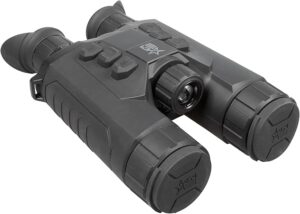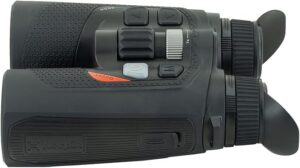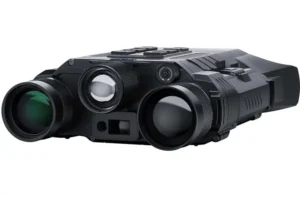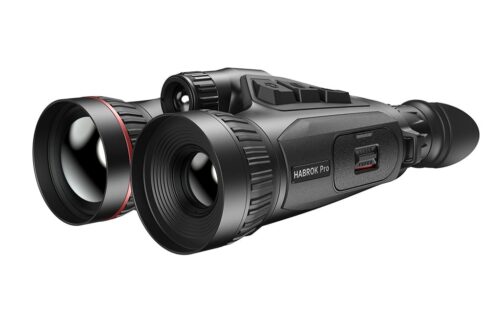If you’re hunting early in the morning, late in the evening, or in low-visibility terrain, and looking for the best thermal binoculars for hunting, you are in the right place. These binoculars are one of the most powerful tools you can carry, and we are here to help you find the ideal pair for your hunting needs.
Thermal binoculars detect infrared radiation instead of relying purely on visible light. This means they work in darkness, fog, or through heavy vegetation where normal optics struggle. Additionally, these binoculars give you a detection advantage, helping you spot an animal before it spots you.
What to Look for in Thermal Binoculars for Hunting?
-
Sensor resolution: A higher-resolution sensor, such as 640×480 or above, gives sharper images and better detail.
-
Thermal sensitivity (NETD / sNETD value): The smaller the number, for example < 25 mK, the better the device will perform in low-contrast situations of dawn, dusk, and brush.
-
Detection / recognition range: For hunting in open terrain you’ll need longer range. In heavier cover the field of view and agility matter more.
-
Magnification / field of view: Too high magnification in dense terrain can slow scanning while too low in open terrain may limit useful range. It is therefore important to find the right balance for optimal performance.
-
Ergonomics / weight / comfort: Since you may carry the device for long periods, comfort matters. Besides, dual-eye binoculars reduce fatigue vs monocular.
-
Durability / weatherproofing: Lastly, the best thermal binoculars for hunting should be waterproof and shockproof as it often means looking for game in early morning, rain, dew, rough terrain.
Best Thermal Binoculars for Hunting
1) ATN Binox 4T 640 1-10x Thermal Binocular

The ATN BionX 4T 640 are the best thermal binoculars for hunting. This a high-performance tool built for hunters and professional observers who demand clarity, range, and reliable detection in challenging environments.
Its selling point is the Gen 4 640×480 <25 mK sensor. The sensor delivers an exceptionally clean thermal image with strong contrast, making it easy to detect heat signatures through fog, brush, and total darkness.
Furthermore, the 60 Hz refresh rate keeps panning smooth and natural, reducing motion blur and eye fatigue during long sessions. The 1–10x variable magnification gives you both wide-area scanning and precise target identification, while the ergonomic binocular format provides a more comfortable and stable viewing experience than monocular units.
Another impressive feature is its build quality. It is robust with an interface that remains intuitive despite the device’s advanced feature set.
Beyond build quality, the BionX 4T brings a suite of modern capabilities that elevate its field utility. Onboard video recording and compatibility with ATN’s smartphone app make it easy to capture, review, or share footage, and the integrated range finding and ballistic tools add practical value for hunters and tactical users alike.
Pros
- Excellent image clarity from the Gen 4 640×480 <25 mK sensor
- Smooth 60 Hz refresh rate for natural motion and reduced blur
- Versatile 1–10x magnification for both scanning and target ID
- Comfortable binocular design for extended viewing
- Onboard recording and app connectivity for easy sharing
- Useful rangefinding and ballistic features
- Robust build suited for demanding environments
Cons
- Higher price than many competing thermal units
2) AGM Global Vision ObservIR LRF Dual-Spectrum Thermal & Digital Day/Night Vision Binoculars

Equipped with both thermal and digital day/night vision, this device provides clear imaging in any lighting, enhancing detection accuracy and versatility in diverse environments.
The thermal sensor provides strong target detection at long distances, while the high-resolution digital night vision mode keeps images sharp and detailed in low-light scenarios.
Furthermore, the integrated laser rangefinder is a major advantage, offering quick and precise distance readings that enhance situational awareness for hunters, search-and-rescue teams, and tactical users.
Combined with a comfortable ergonomic build, intuitive controls, and onboard recording, the ObservIR LRF is purpose-built for demanding field work. It also impresses with clarity, detection range, and image stability with a refresh rate and processing that deliver smooth thermal imaging.
Above all, battery life is solid for a dual-spectrum system, and the device’s rugged housing stands up to challenging environments.
Pros
- Dual-spectrum system provides both thermal and digital night vision in one unit
- Integrated laser rangefinder for fast, precise distance measurement
- Strong long-range detection and clear image quality
- Rugged, weather-resistant build suitable for demanding environments
- Onboard recording and user-friendly controls
Cons
- Heavier and bulkier than single-purpose optics
- Slight learning curve for new users adjusting to multiple modes and settings
3) Pulsar Merger LRF XT50 2-16x50mm Thermal Imaging Binoculars

As one of the best thermal binoculars for hunting, the Pulsar Merger LRF XT50 2–16x50mm Thermal Imaging Binoculars deliver an excellent blend of image clarity, ergonomic design, and long-range capability.
The 640×480 thermal sensor paired with a fast 50mm lens produces crisp heat signatures, even in challenging conditions such as fog, light rain, or cluttered terrain. Furthermore, the binocular-style chassis feels natural and stable, reducing eye fatigue during extended glassing sessions.
Pulsar’s onboard laser rangefinder is another standout feature. It is fast, accurate, and easy to activate, making target identification and distance estimation straightforward. Moreover, the adjustable 2–16x magnification offers versatility for tracking close targets while retaining enough resolution to observe distant heat signatures without losing detail.
In real-world use, the XT50 impresses with smooth image processing, intuitive controls, and a robust build that withstands cold, moisture, and rough field handling. It also brings to the table image modes, color palettes, and picture-in-picture function that allows precise customization for different environments and spotting scenarios.
Pros
- Excellent image quality with a high-resolution sensor
- Ergonomic binocular design reduces eye fatigue
- Fast and accurate laser rangefinder
- Wide magnification range for close and long-distance viewing
- Rugged, weather-resistant build
- Useful image modes and picture-in-picture feature
Cons
- High price compared to mid-range thermals
- The battery drains quickly at high magnification
4) NOCPIX QUEST H50R 50mm Rangefinding Thermal Binocular

Next, we have the NOCPIX QUEST H50R. It delivers a strong blend of range-finding capability, long-distance detection, and practical field performance for hunters and nighttime observers who need both clarity and situational awareness.
Its 50mm germanium lens offers a wide thermal field and impressive detection reach, allowing you to spot large game well beyond typical engagement distances. Furthermore, the onboard laser rangefinder adds real utility when estimating distance in challenging terrain, while the high-resolution sensor and responsive display help maintain crisp target outlines even in poor weather.
Regarding construction, these binoculars are crafted ready for rugged outdoor use. The overall build is rugged and field-ready, with controls laid out in a way that’s intuitive during both daytime scouting and nighttime hunts.
Battery performance is another strength, providing extended runtime suitable for long tracking sessions. The multiple imaging palettes make it easy to adjust for different environments and the unit’s onboard recording and Wi-Fi app support also add value for users who like documenting hunts or sharing thermal footage.
Pros
- Strong detection range with a quality 50mm lens
- Built-in laser rangefinder for accurate distance measurement
- Rugged and ergonomic construction
- Good battery life for prolonged use
- Multiple color palettes and smooth image processing
- Onboard photo/video recording and wireless connectivity
Cons
- High price point compared to simpler optics
- Learning curve for new users due to the feature set
5) PARD Optics Osprey 3.5x35mm Dual-Spectral Binocular w/LRF

The PARD Optics Osprey 3.5x35mm Dual-Spectral Binocular delivers impressive versatility for hunters and wildlife observers who demand both thermal and digital night vision capabilities in one unit.
Its dual-spectral design combines a 640×512 thermal sensor with a full-color optical channel, allowing seamless switching between visible light and thermal imaging depending on the lighting or environmental conditions.
Furthermore, the 3.5x base magnification paired with digital zoom provides clear mid- to long-range identification, while the 35mm objective lens ensures a bright, detailed image even in low light.
Construction-wise, its compact build and ergonomic controls make it comfortable for extended field use, and the IP67 waterproof rating gives confidence in harsh outdoor environments.
Performance-wise, the Osprey impresses with its fast image processing, crisp thermal contrast, and smooth refresh rate that makes tracking moving targets easier. It also brings to the table built-in recording and Wi-Fi connectivity that let users capture and share footage instantly, enhancing its appeal for field documentation and scouting.
Pros
- Dual-spectral system combines thermal and digital night vision in one device
- Sharp 640×512 thermal resolution and bright 35mm lens
- Durable IP67 waterproof and dustproof housing
- Intuitive controls and ergonomic grip for field use
- Wi-Fi and video recording capabilities for easy sharing
Cons
- Heavier than conventional night vision binoculars
- Higher price point compared to single-spectrum models
6. ATN BinoX 4K 4-16X Smart Day/Night Binoculars with Laser Range Finder

Last but not least, we have the ATN BinoX 4K 4-16X Smart Day/Night Binoculars with Laser Range Finder.
As one of the best thermal binoculars for hunting, it blends traditional glassing with modern digital capability, offering hunters and outdoor users a highly versatile optic that performs around the clock.
Its 4K Ultra HD sensor delivers crisp detail during the day and surprisingly clean nighttime visibility, making it a dependable tool for spotting game, tracking movement, or observing wildlife after dark. Furthermore, the zoom range gives you flexibility across varying distances, and the onboard image stabilization helps maintain clarity even when you’re fully zoomed in.
For added convenience, the interface is intuitive, allowing quick access to focus, magnification, and smart features without slowing you down. On top of that, its integration of smart technology includes a built-in laser rangefinder that provides accurate distance measurements with a quick press.
To top it all off, the ATN’s smart functions, such as video recording, Wi-Fi streaming, Bluetooth connectivity, and the ability to sync with other ATN devices, add a level of convenience that standard binoculars can’t match.
Pros
- Excellent 4K day and night image quality
- Built-in laser rangefinder for quick distance readings
- Smart features like video recording and Wi-Fi/Bluetooth connectivity
- Strong battery life for a digital binocular
- Rugged construction suitable for field use
Cons
- The digital zoom softens image detail at higher magnification
- The menu and smart features require a learning curve
Criteria for Choosing the Best Thermal Binoculars for Hunting
Here are the key factors to consider when shopping for the best thermal binoculars for hunting:
Image Resolution and Clarity
Firstly, consider image resolution and clarity. The resolution of the thermal sensor and display determines how sharp and detailed the image will be. Higher resolution helps you not just spot something, but identify it in the field. If you’re hunting in open terrain or need to detect game at longer distances, aim for higher‑resolution models.
Detection and Identification Range
It’s not enough just to see heat signatures far off. You need to recognize them. A good hunting thermal binocular should allow you to detect a target at a distance that matches your terrain and hunting style, and then identify what it is reliably. The farther you need to scan in open plains or mountains, the longer the range you’ll need.
Thermal Sensitivity and Performance in Challenging Conditions
Thermal sensitivity matters when ambient conditions are tough. Better sensitivity yields clearer distinction of animals against background clutter and in low contrast. For serious hunting, this can make the difference between usable or disappointing performance.
Field of view
Next, consider field of view. A wide FOV helps when you are scanning broad areas or looking for movement in dense cover. Higher magnification or larger lenses help when you want to identify distant targets, but there is a trade‑off. Zooming in often narrows the FOV, making scanning slower and possibly missing movement. Choose a model whose optical setup suits your terrain (forest vs open plains) and style (stalking vs stand hunting).
Refresh rate and display quality
When hunting moving game or panning across terrain a higher refresh rate means smoother image updates, reducing motion‑blur and lag. This makes tracking animals easier. Also, the display should be comfortable to use with good contrast, capable of different color palettes if needed, so your eyes don’t fatigue when you’re glassing for hours.
Ergonomics, Weight, Battery Life and Usability
A hunting optic must perform in the field, often after long carries, in uncomfortable weather. Weight and balance matter when you carry it for hours, while a long battery life is crucial for continuous operation during lengthy hunting periods. Moreover, the best thermal binoculars for hunting should have user‑friendly controls.
Durability, Weather‑Proofing, and Suitability for the Terrain
Lastly, the device must withstand the elements, rain, fog, dust, cold/heat swings, and even recoil if handheld but used in conjunction with shooting gear. A thermal binocular made for hunting should be rugged as well to withstand impacts and rough handling.
Tips to Improve Night and Low-Light Game Tracking
- Scout during twilight: Animals are more active at dawn and dusk, making tracking easier
- Move quietly: Minimize noise and sudden movements to avoid spooking game
- Understand animal habits: Know feeding, watering, and bedding areas for better tracking
- Use natural cover and shadows: Stay hidden while observing or approaching animals
- Monitor wind direction: Stay downwind to prevent your scent from alerting game
- Enhance contrast perception: Adjust thermal brightness and color palettes for clarity
- Plan routes with terrain in mind: Identify vantage points, clearings, and trails for effective observation
- Use reflective or low-light markers: Mark paths or spots to navigate safely without bright lights. Slow your movements and scan carefully to increase detection chances
How to Maintain Thermal Binoculars
Proper care of your thermal binoculars is important to ensure clear imaging, reliable performance, and a longer lifespan. Here are tips to care for your model:
1. Keep Lenses Clean. Use a microfiber cloth or lens brush; avoid touching with fingers. For smudges, use lens cleaning solution.
2. Protect from Moisture. Store the binoculars in a dry, cool place with desiccant packs. Wipe off rain or condensation immediately.
3. Battery Care. The best thermal binoculars are battery powered. Remove batteries when not in use. Use compatible batteries and avoid overcharging.
4. Safe Storage. When not is use, keep the binoculars in a padded case away from heat and direct sunlight.
5. Handling. Use the neck/shoulder strap to avoid drops or shocks. Don’t open the housing yourself.
6. Firmware and Inspection. Check for firmware updates if supported. Furthermore, inspect for cracks, loose parts, or malfunction regularly.
7. Limit Harsh Exposure. Limit exposure to extreme cold or heat to prevent damage to electronics.
If used in cold weather, allow the binoculars to warm up gradually indoors to prevent condensation inside.
Read Also
FAQs
- Is higher magnification always better?
Not necessarily. High magnification helps in open terrain when you need to see far away. But in dense bush or close‑range hunting you may prefer a lower magnification with a wider field of view so you can scan more area and pick up movement easier. Also, high magnification degrades image quality and makes the optics heavier.
- Can thermal binoculars be used both day and night?
Yes. Thermal binoculars detect heat rather than relying on visible light, so they work in full darkness and during daytime. They’re effective even when the sun is up, though strong sunlight reduces apparent contrast because ambient background heat rises.
- Are there restrictions on using thermal binoculars for hunting?
Yes. In some jurisdictions, using thermal imaging devices or electronics may be restricted especially if used during night hunts, or considered artificial light or electronic aid in ways that change what’s allowed. Always verify local game laws, seasonal restrictions, and permitted gear.
Final Words
In conclusion, thermal binoculars are a powerful tool for hunters, offering unmatched visibility in complete darkness, fog, or dense terrain. Choosing the right model depends on balancing detection range, image quality, magnification, durability, and battery life with your specific hunting conditions. . Always prioritize practical performance over flashy features, and ensure your gear complies with local hunting regulations.

